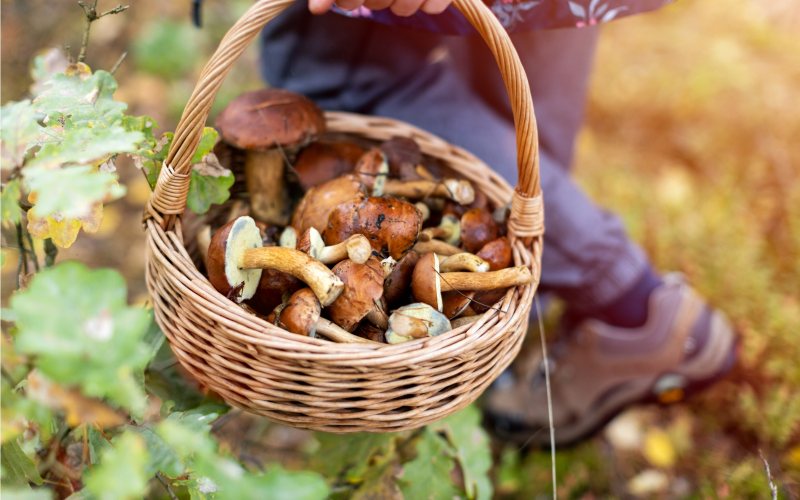This spring and summer, look out for wild mushrooms all over the province! We present the star of our forests, the morel, and another favourite, the oyster mushroom, and tell you how to prepare them. We also have tips on picking them.
The morel: a woodland treasure
Oddly shaped with a honeycomb top, the morel offers 22 edible species growing all over North America. It comes in a variety of colours, though Quebec primarily has the blonde and black varieties. Very popular the world over, it is sometimes abundant, sometimes scarce from year to year, depending on location. Many are willing to pay the price to enjoy these precious fungi.
Generally speaking, the morel strives on basic, sandy soil from burned down forests (particularly those that were populated by pine, spruce, aspen, poplar, and birch trees). It grows on both flat ground and hills bordering forests, on damp, warm (but not too warm) soil.
In your plate from appetizer to dessert
With its delicate nutty flavour, the morel can be used in both sweet and savoury dishes. Experience its full potential by adding it to risottos with parmesan, ice cider, and lemon zest, pasta, and scrambled eggs, or making it as a sauce for your vol-au-vent. For dessert, its powdered form adds a very special touch to pear and almond cake, like the one in this recipe.
Can’t decide between sweet and savoury? Have both! Add sliced bananas, fresh morels sauteed in butter, and arugula to toasted loaf bread. Next, drizzle some lemon juice and maple syrup on top, and add salt and pepper. Voilà! Enjoy an impressive new blend of flavours.
To ensure you have morels at your disposal when you need them, try the dehydrated variety by Morille Québec, available at Rachelle Béry. Simply rehydrate them in water before adding them to your recipes. You can also use them as is in your broths, bases, and sauce, or powder them and use them as seasoning for stuffing, bread, meat, fish, etc.
Looking for oyster mushrooms? Knock on wood!
A kitchen favourite, oyster mushrooms grow in bunches on living or dead wood from deciduous trees such as maple, oak, beech, and hickory trees, as well as on organic materials such as straw and bark. With little to no stump, these mushrooms are reminiscent of pretty seashells. They are commonly found all throughout summer, until October. However, they must be picked early—as soon as they sprout—as they can quickly turn tough or be invaded by insects.
Balancing pronounced flavours
Given their somewhat firm flesh, it is best to cook oyster mushrooms slowly, over low heat. They make for a mean pesto after being browned in a pan and mixed with toasted pine nuts, parmesan, parsley, and fresh thyme, garlic flower, lemon juice, salt, and pepper. They’re also incredible with beef in a stew, or with spinach in a stir fry.

Safety first and foremost
Increasingly popular year after year, wild mushroom picking is the perfect opportunity to get some fresh air and gather what is sure to elevate a variety of dishes. Before diving in, knife in hand no less, there are some precautions you should take to avoid any unpleasant surprises; several toxic species can cause food poisoning, and even be fatal in rare, extreme cases.
The picking
First off, we highly recommend starting your venture into mycology with the help of an expert, as part of supervised workshops. They will teach you how to differentiate edible varieties from non-edible ones, as well as how to use available identification guides. Also, to make identification easier, it is best to pick well developed varieties, as very small ones can lead to confusion. The golden rule: when in doubt, leave it.
Next, avoid soiled mushrooms and those infested or eaten by insects, as well as those showing signs of aging (think rotting or decomposition).
The picking location should also be considered: is it near septic tanks or in an area where chemical, pesticide, or herbicide products were applied? If so, move along.
At home
Immediately store your mushrooms in a paper bag in the fridge.
Wash them well before cooking.
Always cook your wild mushrooms so as to disgorge them completely: several minutes are often needed for this (dispose of the water extracted).
Allergies and intolerances
When trying a new mushroom variety for the first time, start with small quantities to ensure you are not allergic or intolerant.
Those who are allergic to button mushrooms should avoid consuming wild ones.
Where to look for fungi?
Quebec’s forests are a goldmine for wild mushroom lovers. Here are a few popular places you can visit to learn more about fungi with the help of a mycology specialist.
-
Gourmet Sauvage, Laurentians
-
Parc régional du Massif du Sud, Chaudière-Appalaches
-
Myco Tourisme Kamouraska, Bas-Saint-Laurent
-
Vallée Rocanigan, Mauricie
-
Mycoboutique, Centre-du-Québec
-
Forêt Hereford, Eastern Townships
-
Cap Jaseux, Saguenay-Lac-Saint-Jean
Express “excursion” at the grocery store
No time to venture into the forest? Go to Rachelle Béry, where you’ll find a wide variety of organic mushrooms: king oyster, enoki, portobello tops, shiitake, etc. There’s something for everyone!

